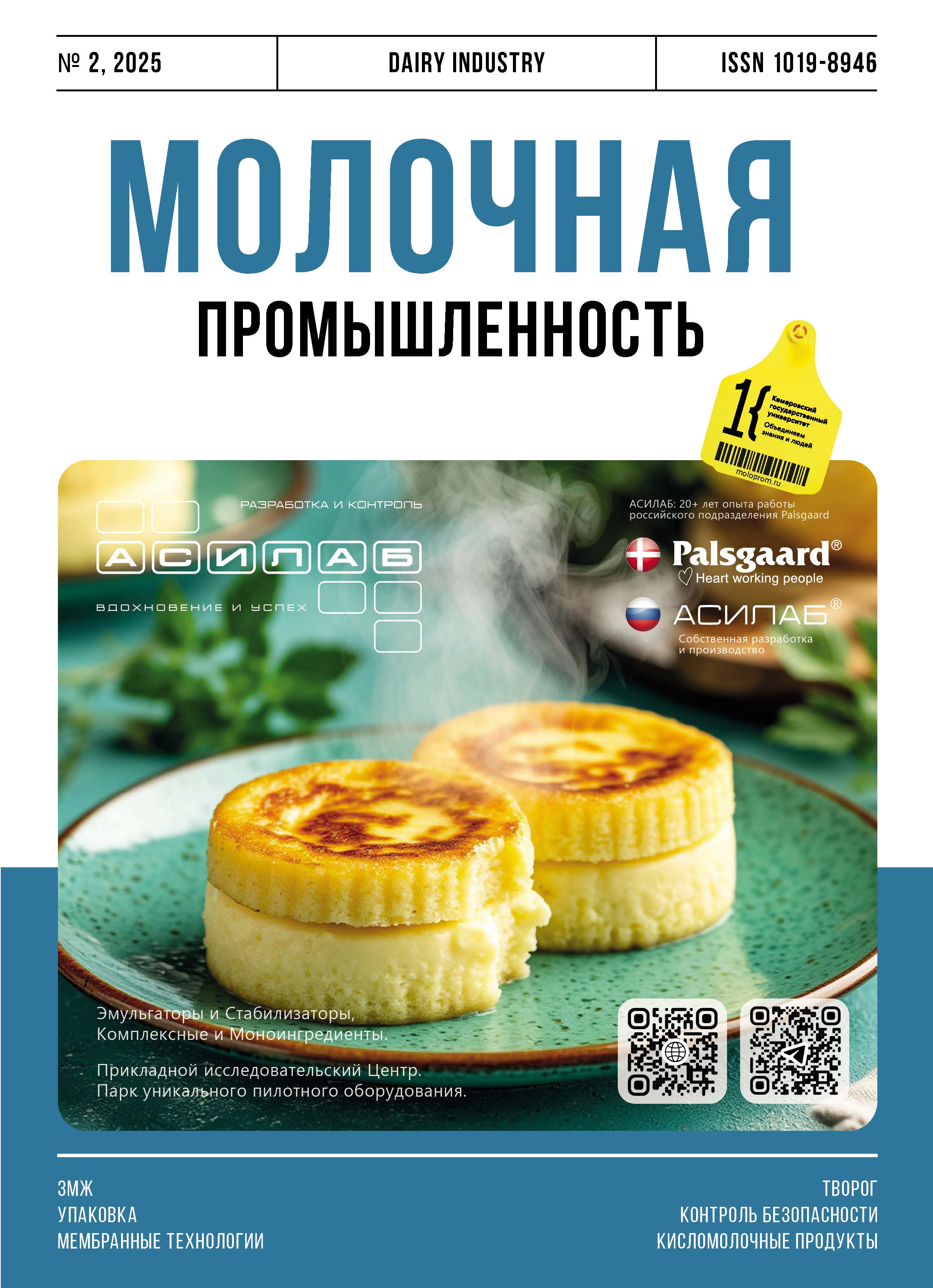Kemerovo, Russian Federation
Kemerovo, Kemerovo, Russian Federation
Kemerovo, Russian Federation
Kemerovo, Russian Federation
Moscow, Russian Federation
Latex coating systems based on polysaccharides are known to possess antibacterial properties that protect food products by affecting their structural and mechanical profile. The authors selected additives with antibacterial properties to develop latex compositions and studied their structural and mechanical properties. An unmodified latex base served as control. The experimental samples contained alcohol extracts of propolis and chamomile. The film samples were tested for the residual elongation after rupture, tensile strength, infrared spectroscopy, moisture mass fraction, and drying kinetics. The optimal share of antibacterial alcoholic extracts was 20%. The best relative residual elongation after rupture belonged to the modified systems with 10% chamomile and propolis. In the spectroscopy test, the smallest intermolecular distance was observed in the sample with 10% propolis extract. The further tests on drying speed and kinetics involved the samples with 20% additives vs. the control. The prototype with 20% propolis extract demonstrated the best results. The modified systems with alcohol extracts of chamomile showed satisfactory rheological properties. The alcohol extracts proved to be able to affect the strength, drying rate, and kinetics of the modified latex systems.
latex, propolis extract, wild chamomile, antibacterial packaging, food additives
1. Petrickaya, E. N. K voprosu o toksichnosti nanochastic serebra pri peroral'nom vvedenii kolloidnogo rastvora / E. N. Petrickaya, L. F. Abaeva, D. A. Rogatkin [i dr.] // Al'manah klinicheskoy mediciny. 2011. № 25. S. 9–12. https://elibrary.ru/onjtgd
2. Rozalenok, T. A. Issledovanie i razrabotka antimikrobnoy kompozicii dlya pischevyh upakovok / T. A. Rozalenok, Yu. Yu. Sidorin // Tehnika i tehnologiya pischevyh proizvodstv. 2014. № 2(33). S. 130–134. https://elibrary.ru/sepqsx
3. Dyshlyuk, L. S. Teoreticheskoe obosnovanie i prakticheskaya realizaciya tehnologiy polucheniya antimikrobnyh plenok na osnove polisaharidov i ih proizvodnyh dlya pischevoy promyshlennosti: dis. … d-ra tehn. nauk 03.01.06 / L. S. Dyshlyuk. – Kemerovo, 2021. – 471 s.
4. Napreev, K. S. Vliyanie antibakterial'noy biologicheski aktivnoy dobavki iz ekstrakta propolisa na razlichnye shtammy vredonosnyh mikroorganizmov / K. S. Napreev, R. V. Kryuk, M. G. Kurbanova, O. I. Kalugina // Pischevye tehnologii : Sbornik tezisov III Mezhdunarodnogo Simpoziuma, posvyaschennogo 90-letiyu so dnya rozhdeniya doktora tehnicheskih nauk, professora, zasluzhennogo deyatelya nauki i tehniki RF, osnovatelya nauchnoy shkoly L'va Aleksandrovicha Ostroumova, Kemerovo, 20–21 sentyabrya 2024 goda. – Kemerovo: Kemerovskiy gosudarstvennyy universitet, 2024. – S. 287–289. – https://elibrary.ru/ogkiuo
5. Kryuk, R. V. Izuchenie antimikrobnoy aktivnosti s cel'yu sozdaniya sovremennyh kompoziciy upakovochnyh struktur / R. V. Kryuk, K. S. Napreev, M. G. Kurbanova [i dr.] // Pischevye zdorov'esberegayuschie tehnologii : Sbornik tezisov II Mezhdunarodnogo Simpoziuma, posvyaschennogo 50-letiyu KemGU, Kemerovo, 02–03 noyabrya 2023 goda. – Kemerovo: Kemerovskiy gosudarstvennyy universitet, 2023. – S. 388–391. – https://elibrary.ru/naaluq
6. Bol'shakova, V. F. Opyt primeneniya propolisa v dermatologii // Cennyy produkt pchelovodstva: propolis / otv. red. O. Andrich. – Buharest: Apimondiya, 1987. – S. 130–133.
7. Karomatov, I. D. Propolis: ispol'zovanie v medicine / I. D. Karomatov // Molodoy uchenyy. 2014. № 3(62). S. 183–199. https://elibrary.ru/rxeevp
8. Fang, Ch. Issledovanie terapevticheskih effektov propolisa // Cennyy produkt pchelovodstva: propolis / otv. red. O. Andrich. – Buharest: Apimondiya, 1987. – S. 24–27.
9. Duke, J. A. Handbook of medicinal herbs / J. A. Duke. – Florida: CRC Press, 2002. – P. 174–176.
10. Franke, R. Chamomile: Industrial Profiles / R. Franke, H. Schilcher. – Florida: CRC Press, 2005. – 304 p.
11. Zagorul'ko, E. Yu. Podhody k standartizacii cvetkov romashki aptechnoy (Chamomillae recutita flores) v rossiyskoy i zarubezhnyh farmakopeyah / E. Yu. Zagorul'ko, M. G. Ozhigova // Farmaciya i farmakologiya. 2017. T. 5, № 2. S. 135–149. https://doi.org/10.19163/2307-9266-2017-5-2-135-149; https://elibrary.ru/yzmcpl
12. Alahmady, N. F. Biochemical characterization of chamomile essential oil: Antioxidant, antibacterial, anticancer and neuroprotective activity and potential treatment for Alzheimer's disease / N. F. Alahmady [et al.] // Saudi Journal of Biological Sciences. 2024. Vol. 31(2). 103912. https://doi.org/10.1016/j.sjbs.2023.103912







